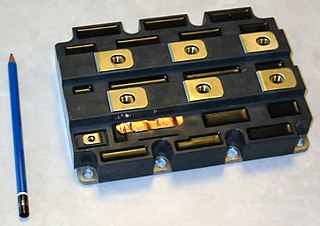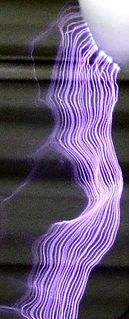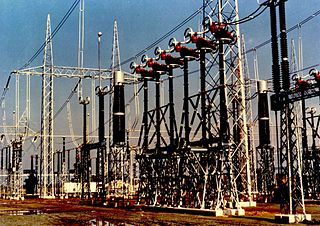
An electrical insulator is a material in which electric current does not flow freely. The atoms of the insulator have tightly bound electrons which cannot readily move. Other materials—semiconductors and conductors—conduct electric current more easily. The property that distinguishes an insulator is its resistivity; insulators have higher resistivity than semiconductors or conductors. The most common examples are non-metals.

An insulated-gate bipolar transistor (IGBT) is a three-terminal power semiconductor device primarily used as an electronic switch, which, as it was developed, came to combine high efficiency and fast switching. It consists of four alternating layers (P–N–P–N) that are controlled by a metal–oxide–semiconductor (MOS) gate structure.

The Wimshurst influence machine is an electrostatic generator, a machine for generating high voltages developed between 1880 and 1883 by British inventor James Wimshurst (1832–1903).

A substation is a part of an electrical generation, transmission, and distribution system. Substations transform voltage from high to low, or the reverse, or perform any of several other important functions. Between the generating station and consumer, electric power may flow through several substations at different voltage levels. A substation may include transformers to change voltage levels between high transmission voltages and lower distribution voltages, or at the interconnection of two different transmission voltages.
In electrical engineering, partial discharge (PD) is a localized dielectric breakdown (DB) of a small portion of a solid or fluid electrical insulation (EI) system under high voltage (HV) stress. While a corona discharge (CD) is usually revealed by a relatively steady glow or brush discharge (BD) in air, partial discharges within solid insulation system are not visible.

A Lichtenberg figure, or Lichtenberg dust figure, is a branching electric discharge that sometimes appears on the surface or in the interior of insulating materials. Lichtenberg figures are often associated with the progressive deterioration of high voltage components and equipment. The study of planar Lichtenberg figures along insulating surfaces and 3D electrical trees within insulating materials often provides engineers with valuable insights for improving the long-term reliability of high-voltage equipment. Lichtenberg figures are now known to occur on or within solids, liquids, and gases during electrical breakdown.

Electrical breakdown or dielectric breakdown is a process that occurs when an electrical insulating material, subjected to a high enough voltage, suddenly becomes an electrical conductor and electric current flows through it. All insulating materials undergo breakdown when the electric field caused by an applied voltage exceeds the material's dielectric strength. The voltage at which a given insulating object becomes conductive is called its breakdown voltage and in addition to its dielectric strength depends on its size and shape, and the location on the object at which the voltage is applied. Under sufficient electrical potential, electrical breakdown can occur within solids, liquids, or gases. However, the specific breakdown mechanisms are different for each kind of dielectric medium.

High voltage electricity refers to electrical potential large enough to cause injury or damage. In certain industries, high voltage refers to voltage above a certain threshold. Equipment and conductors that carry high voltage warrant special safety requirements and procedures.

An overhead power line is a structure used in electric power transmission and distribution to transmit electrical energy across large distances. It consists of one or more uninsulated electrical cables suspended by towers or poles.

In an electric power system, switchgear is composed of electrical disconnect switches, fuses or circuit breakers used to control, protect and isolate electrical equipment. Switchgear is used both to de-energize equipment to allow work to be done and to clear faults downstream. This type of equipment is directly linked to the reliability of the electricity supply.
Transformer oil or insulating oil is an oil that is stable at high temperatures and has excellent electrical insulating properties. It is used in oil-filled transformers, some types of high-voltage capacitors, fluorescent lamp ballasts, and some types of high-voltage switches and circuit breakers. Its functions are to insulate, suppress corona discharge and arcing, and to serve as a coolant.
In electronics, a bleeder resistor, bleeder load, leakage resistor, capacitor discharge resistor or safety discharge resistor is a resistor connected in parallel with the output of a high-voltage power supply circuit for the purpose of discharging the electric charge stored in the power supply's filter capacitors when the equipment is turned off, for safety reasons. It eliminates the possibility of a leftover charge causing electric shock if people handle or service the equipment in the off state, believing it is safe. A bleeder resistor is usually a standard resistor rather than a specialized component.

In electric power, a bushing is a hollow electrical insulator that allows an electrical conductor to pass safely through a conducting barrier such as the case of a transformer or circuit breaker without making electrical contact with it. Bushings are typically made from porcelain; though other insulating materials are also used.

A variety of types of electrical transformer are made for different purposes. Despite their design differences, the various types employ the same basic principle as discovered in 1831 by Michael Faraday, and share several key functional parts.

In the electric power distribution industry, a hot stick is an insulated pole, usually made of fiberglass, used by electric utility workers when engaged on live-line working on energized high-voltage electric power lines, to protect them from electric shock. Depending on the tool attached to the end of the hot stick, it is possible to test for voltage, tighten nuts and bolts, apply tie wires, open and close switches, replace fuses, lay insulating sleeves on wires, and perform various other tasks while not exposing the crew to a large risk of electric shock.

In electrical engineering, live-line working, also known as hotline maintenance, is the maintenance of electrical equipment, often operating at high voltage, while the equipment is energised. Although this is more hazardous for personnel than working on electrical equipment with the power off, live-line maintenance techniques are used in the electric power distribution industry to avoid the disruption and high economic costs of having to turn off power to customers to perform essential periodic maintenance on transmission lines and other equipment.

A high-voltage cable is a cable used for electric power transmission at high voltage. A cable includes a conductor and insulation. Cables are considered to be fully insulated. This means that they have a fully rated insulation system that will consist of insulation, semi-con layers, and a metallic shield. This is in contrast to an overhead line, which may include insulation but not fully rated for operating voltage. High-voltage cables of differing types have a variety of applications in instruments, ignition systems, and alternating current (AC) and direct current (DC) power transmission. In all applications, the insulation of the cable must not deteriorate due to the high-voltage stress, ozone produced by electric discharges in air, or tracking. The cable system must prevent contact of the high-voltage conductor with other objects or persons, and must contain and control leakage current. Cable joints and terminals must be designed to control the high-voltage stress to prevent the breakdown of the insulation.
A dielectric gas, or insulating gas, is a dielectric material in gaseous state. Its main purpose is to prevent or rapidly quench electric discharges. Dielectric gases are used as electrical insulators in high voltage applications, e.g. transformers, circuit breakers, switchgear, radar waveguides, etc.

Film capacitors, plastic film capacitors, film dielectric capacitors, or polymer film capacitors, generically called film caps as well as power film capacitors, are electrical capacitors with an insulating plastic film as the dielectric, sometimes combined with paper as carrier of the electrodes.

A dielectric withstand test is an electrical test performed on a component or product to determine the effectiveness of its insulation. The test may be between mutually insulated sections of a part or energized parts and electrical ground. The test is a means to qualify a device's ability to operate safely during rated electrical conditions. If the current through a device under test is less than a specified limit at the required test potential and time duration, the device meets the dielectric withstand requirement. A dielectric withstand test may be done as a factory test on new equipment, or may be done on apparatus already in service as a routine maintenance test.
















